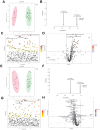Plasma nontargeted metabolomics study of H1N1 and H3N2 influenza in children
- PMID: 40256448
- PMCID: PMC12006178
- DOI: 10.3389/fcimb.2025.1537726
Plasma nontargeted metabolomics study of H1N1 and H3N2 influenza in children
Abstract
Background: This study used a nontargeted metabolomic approach to investigate small molecular metabolites in the peripheral blood of pediatric patients with influenza. By comparing these metabolites with those in healthy children, potential biomarkers for the early detection and diagnosis of influenza were explored.
Methods: Plasma samples were collected from 47 children with H1N1 influenza, 40 with H3N2 influenza, and 40 healthy controls at Xi'an Children's Hospital, Xi'an Jiaotong University Second Affiliated Hospital, and Xi'an Central Hospital between May and September 2023. Nontargeted metabolomic detection and analysis were performed.
Results: In the H1N1 group, 14 glycerophospholipid metabolites were significantly altered compared to controls, with 11 (78.5%) markedly downregulated. These downregulated metabolites showed negative correlations with inflammatory markers, including white blood cell (WBC) count, neutrophils, C-reactive protein (CRP), and Procalcitonin (PCT), whereas the upregulated metabolite PC(P-18:1(9Z)/16:0) showed positive correlations with validation markers. In the H3N2 group, 12 glycerophospholipid metabolites were significantly altered, with 9 being downregulated. The downregulated LysoPC(20:0/0:0) showed a positive correlation with alanine aminotransferase (ALT) but a negative correlation with WBC count, while the upregulated metabolite LysoPA(18:1(9Z)0:0) correlated positively with ALT, aspartate aminotransferase (AST), and lactate dehydrogenase (LDH).
Conclusions: Distinct metabolomic profiles were identified in pediatric H1N1 and H3N2 influenza cases compared to healthy controls. Specific glycerophospholipid metabolites were closely associated with inflammatory and liver function markers, highlighting their potential as biomarkers for disease monitoring and early diagnosis.
Keywords: biomarker; differentially abundant metabolites; early diagnosis; influenza virus; plasma metabolomics.
Copyright © 2025 Li, Li, Li, Liu, Du, Li, Chen, Zhang, Wang, Wang, Jia and Deng.
Conflict of interest statement
The authors declare that the research was conducted in the absence of any commercial or financial relationships that could be construed as a potential conflict of interest.
Figures




Similar articles
-
Combination of procalcitonin and C-reactive protein levels in the early diagnosis of bacterial co-infections in children with H1N1 influenza.Influenza Other Respir Viruses. 2019 Mar;13(2):184-190. doi: 10.1111/irv.12621. Epub 2018 Dec 1. Influenza Other Respir Viruses. 2019. PMID: 30443990 Free PMC article.
-
Characterization of serum metabolome and respiratory microbiota in children with influenza A virus infection.Front Cell Infect Microbiol. 2025 Jan 30;14:1478876. doi: 10.3389/fcimb.2024.1478876. eCollection 2024. Front Cell Infect Microbiol. 2025. PMID: 39949573 Free PMC article.
-
[Surveillance for influenza A virus infections in infants and young children in Beijing, China, 2001-2005].Zhonghua Er Ke Za Zhi. 2006 Jul;44(7):518-22. Zhonghua Er Ke Za Zhi. 2006. PMID: 17044978 Chinese.
-
Discriminant biomarkers of acute respiratory distress syndrome associated to H1N1 influenza identified by metabolomics HPLC-QTOF-MS/MS platform.Electrophoresis. 2017 Sep;38(18):2341-2348. doi: 10.1002/elps.201700112. Epub 2017 Aug 25. Electrophoresis. 2017. PMID: 28714069
-
Metabolomics in Childhood Asthma - a Promising Tool to Meet Various Clinical Needs.Curr Allergy Asthma Rep. 2025 May 9;25(1):24. doi: 10.1007/s11882-025-01198-6. Curr Allergy Asthma Rep. 2025. PMID: 40341431 Free PMC article. Review.
References
MeSH terms
Substances
LinkOut - more resources
Full Text Sources
Medical
Research Materials
Miscellaneous

